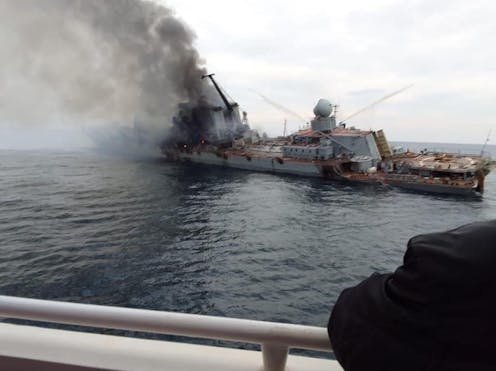
A view of the Russian warship Moskva just before it sank April 15, 2022. Blake Spendley/OSINTtechnical on X
Since the Russian invasion began in 2022, Ukraine has successfully resisted its opponents on many fronts, but its most surprising success came in a theater where few expected Ukraine to prevail: the Black Sea.
In 2022, the consensus among military analysts was that Russian leader Vladimir Putin’s military would most likely crush Ukrainian forces in the air, on land and at sea. With a vast infusion of financial assistance and weapons from the U.S. and Western nations, Ukraine has, however, fought Russia to a standstill on land. On the sea, the Ukrainians have had greater success and have launched a revolution in weapons and tactics that offer both lessons and warnings for the world’s navies.
When Moscow’s invasion began, Ukraine’s only warship was a Soviet-era frigate that had to be scuttled in the Ukrainian port of Mykolaiv to prevent it from falling into Russian hands. Unchallenged on the seas, the Russian navy rained ballistic missiles down on Ukrainian cities, provided protection for military aircraft, blockaded Ukrainian ports and was preparing to launch an amphibious attack on Ukraine’s largest port, Odesa.
But, deploying a series of new tactics and weapons in what became known as the Battle of the Black Sea, the Ukrainians have been able to destroy 26 Russian vessels since the start of the war and force Russia’s powerful Black Sea Fleet to flee hundreds of miles to a safer harbor. This historic success offers a lesson in how weaker powers can take advantage of innovative thinking and new technology to defeat more powerful opponents.
First victory: Sinking the Moskva
From the invasion’s beginning in late February 2022, the Moskva, a guided-missile cruiser that served as the flagship of the Black Sea Fleet, played a key role in Russia’s naval campaign against Ukraine. Perhaps its most famous action was in February 2022, when it captured the strategic Ukrainian naval base known as Snake Island – whose defenders reportedly responded to Russian calls for their surrender by saying “Russian warship, go f*** yourself.”
The vessel’s onboard defense systems and ability to operate from more than 60 miles off Ukraine’s coast seemed to make the Moskva, Russia’s third-largest active warship, virtually impervious to attack.
But at approximately 1 a.m. on April 14, 2022, the Ukrainians managed to pinpoint the Moskva’s location via a combination of radar and intelligence information shared by the U.S. A shore-based missile battery then launched two Ukrainian-built Neptune anti-ship missiles that destroyed the Moskva by igniting its ammunition. It was Russia’s first loss of a flagship since the 1904-1905 Russo-Japanese war and the largest warship sunk in battle since World War II.
In the following days, the Russian navy’s smaller ships pulled back, staying 20 miles farther from the Ukrainian coast than they had been. This move severely limited their effectiveness and put an end to Russian plans to launch an amphibious attack on Odesa.
Throughout 2022, the Ukrainians used more missiles to blow up advanced Russian anti-aircraft systems in the Crimean Peninsula and to damage two more Russian ships. These victories, and the Ukrainians’ subsequent recapture of Snake Island, opened the shipping lanes in the western Black Sea for vital Ukrainian grain shipments to global markets.
But Russians’ hopes that their navy would be safer farther out to sea were to be dashed when the Ukrainians began to hunt their ships with another new naval weapon: sea drones.
A look at Ukrainian sea drones’ effectiveness against Russian forces.
Attack of the sea drones
Starting in the spring of 2022, with little external help, the Ukrainians began to design and build the world’s first combat-deployed sea drone, known as the Magura-V5. This explosive-laden vehicle was designed to do what many thought impossible: travel long distances across stormy seas, undetected by radar, and deliver 500 to 700 pounds of explosives to distant targets.
The drones’ first test was to be a night raid on the heart of Russian power in the Black Sea, the naval base at Sevastopol in Russian-occupied Crimea. At 4 a.m. on Oct. 19, 2022, six to eight remotely guided Magura sea drones entered the harbor and damaged the new flagship for the Russian Black Sea Fleet, the frigate Admiral Makarov, and a minesweeper. One naval combat analyst described the first-ever sea drone assault on a naval base as “a turning point in naval strategy.”
Following this victory, the Ukrainians began deploying the drones more widely. Cameras on board the remotely guided craft sent back imagery of their attacks on a variety of Black Sea Fleet vessels, including tugboats, patrol boats, assault boats, corvettes, trawlers, minesweepers and landing ships. In one typical strike, several remotely piloted drones repeatedly struck and sank the Ivanovets, a missile corvette. The dramatic drone footage released by Ukraine’s secretive Group 13 shows the doomed ship’s crew firing into the water as the unmanned vehicles home in on their target. The footage on every bomb-packed drone abruptly ends as it drives into the ship’s hull and explodes.
Ukrainian military footage shows unmanned sea drones attacking a Russian ship.
A tactical retreat, but no safe port
The waves of drone attacks, combined with strikes from cruise missiles supplied to Ukraine by the United Kingdom and France, sank or damaged 26 Russian vessels. These losses ultimately forced the Russians to withdraw most of their fleet from Sevastopol in October 2023.
But if the Russians thought they were safe in their fallback port in distant Novorossiysk, they were wrong. Buoyed by the success of the Magura drones, the Ukrainians developed longer-range sea drones known as Seababies and Mamais. These more advanced drones were used to travel nearly 500 miles across the Black Sea to strike Russian vessels around the new base.
The Seababy drones have also been used to deploy naval mines to sink four ships, to attack the strategic Kerch Bridge linking Russia with Crimea and to carry rocket launchers for shooting missiles at Russian land and sea targets.
The Ukrainians’ sea drone successes are not only cause for celebration in Ukraine, but demonstrate the potential of new ideas and equipment to reshape naval warfare and the balance of military power at sea.
Brian Glyn Williams does not work for, consult, own shares in or receive funding from any company or organization that would benefit from this article, and has disclosed no relevant affiliations beyond their academic appointment.
Advertisement

Advertisement
Contact Us
If you would like to place dofollow backlinks in our website or paid content reach out to info@qhubonews.com











